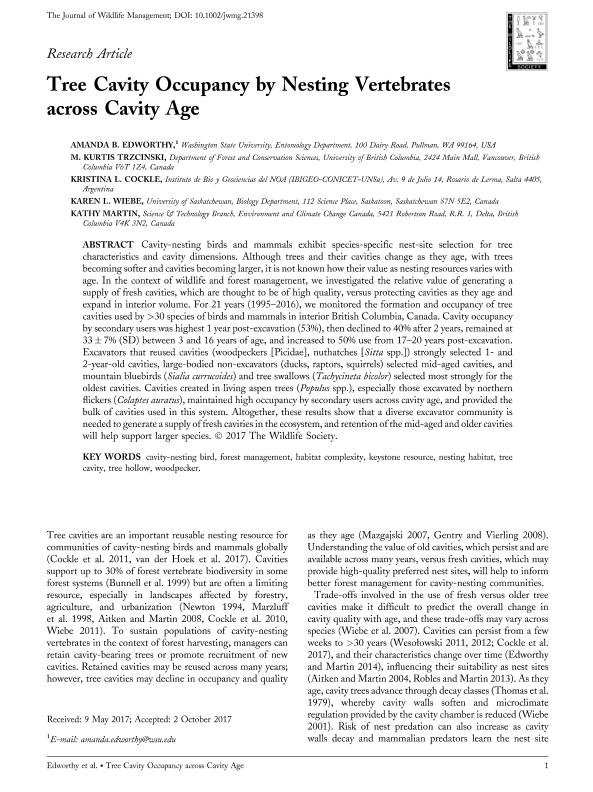Mostrar el registro sencillo del ítem
dc.contributor.author
Edworthy, Amanda B.
dc.contributor.author
Trzcinski, M. Kurtis
dc.contributor.author
Cockle, Kristina Louise

dc.contributor.author
Wiebe, Karen L.
dc.contributor.author
Martin, Kathy
dc.date.available
2018-07-02T21:08:26Z
dc.date.issued
2018-04
dc.identifier.citation
Edworthy, Amanda B.; Trzcinski, M. Kurtis; Cockle, Kristina Louise; Wiebe, Karen L.; Martin, Kathy; Tree cavity occupancy by nesting vertebrates across cavity age; Wildlife Society; Journal of Wildlife Management; 82; 3; 4-2018; 639-648
dc.identifier.issn
0022-541X
dc.identifier.uri
http://hdl.handle.net/11336/50973
dc.description.abstract
Cavity-nesting birds and mammals exhibit species-specific nest-site selection for tree characteristics and cavity dimensions. Although trees and their cavities change as they age, with trees becoming softer and cavities becoming larger, it is not known how their value as nesting resources varies with age. In the context of wildlife and forest management, we investigated the relative value of generating a supply of fresh cavities, which are thought to be of high quality, versus protecting cavities as they age and expand in interior volume. For 21 years (1995–2016), we monitored the formation and occupancy of tree cavities used by >30 species of birds and mammals in interior British Columbia, Canada. Cavity occupancy by secondary users was highest 1 year post-excavation (53%), then declined to 40% after 2 years, remained at 33 ± 7% (SD) between 3 and 16 years of age, and increased to 50% use from 17–20 years post-excavation. Excavators that reused cavities (woodpeckers [Picidae], nuthatches [Sitta spp.]) strongly selected 1- and 2-year-old cavities, large-bodied non-excavators (ducks, raptors, squirrels) selected mid-aged cavities, and mountain bluebirds (Sialia currucoides) and tree swallows (Tachycineta bicolor) selected most strongly for the oldest cavities. Cavities created in living aspen trees (Populus spp.), especially those excavated by northern flickers (Colaptes auratus), maintained high occupancy by secondary users across cavity age, and provided the bulk of cavities used in this system. Altogether, these results show that a diverse excavator community is needed to generate a supply of fresh cavities in the ecosystem, and retention of the mid-aged and older cavities will help support larger species.
dc.format
application/pdf
dc.language.iso
eng
dc.publisher
Wildlife Society

dc.rights
info:eu-repo/semantics/openAccess
dc.rights.uri
https://creativecommons.org/licenses/by-nc-sa/2.5/ar/
dc.subject
Cavity-Nesting Bird
dc.subject
Forest Management
dc.subject
Habitat Complexity
dc.subject
Keystone Resource
dc.subject
Nesting Habitat
dc.subject
Tree Cavity
dc.subject
Tree Hollow
dc.subject
Woodpecker
dc.subject.classification
Otras Ciencias Biológicas

dc.subject.classification
Ciencias Biológicas

dc.subject.classification
CIENCIAS NATURALES Y EXACTAS

dc.title
Tree cavity occupancy by nesting vertebrates across cavity age
dc.type
info:eu-repo/semantics/article
dc.type
info:ar-repo/semantics/artículo
dc.type
info:eu-repo/semantics/publishedVersion
dc.date.updated
2018-06-19T15:59:18Z
dc.journal.volume
82
dc.journal.number
3
dc.journal.pagination
639-648
dc.journal.pais
Estados Unidos

dc.journal.ciudad
Columbia
dc.description.fil
Fil: Edworthy, Amanda B.. Washington State University; Estados Unidos
dc.description.fil
Fil: Trzcinski, M. Kurtis. Center For Applied Conservation Research; Canadá
dc.description.fil
Fil: Cockle, Kristina Louise. Consejo Nacional de Investigaciones Científicas y Técnicas. Centro Científico Tecnológico Conicet - Salta. Instituto de Bio y Geociencias del NOA. Universidad Nacional de Salta. Facultad de Ciencias Naturales. Museo de Ciencias Naturales. Instituto de Bio y Geociencias del NOA; Argentina
dc.description.fil
Fil: Wiebe, Karen L.. University of Saskatchewan; Canadá
dc.description.fil
Fil: Martin, Kathy. Environment and Climate Change Canada; Canadá
dc.journal.title
Journal of Wildlife Management

dc.relation.alternativeid
info:eu-repo/semantics/altIdentifier/url/https://onlinelibrary.wiley.com/doi/epdf/10.1002/jwmg.21398
dc.relation.alternativeid
info:eu-repo/semantics/altIdentifier/doi/http://dx.doi.org/10.1002/jwmg.21398
Archivos asociados
